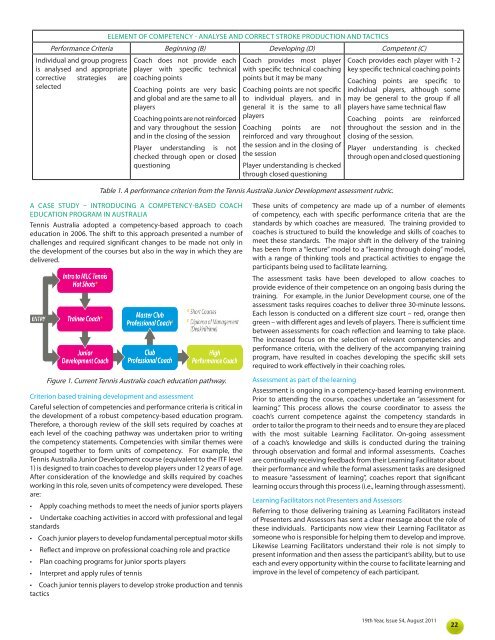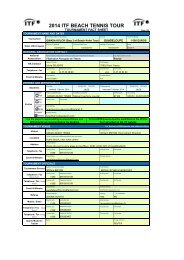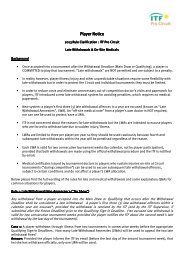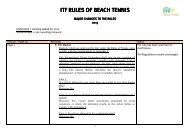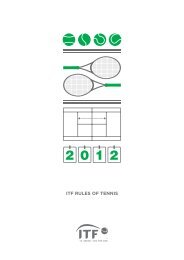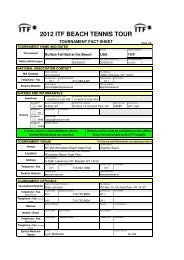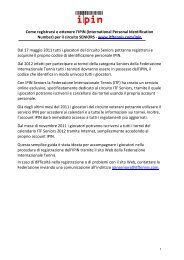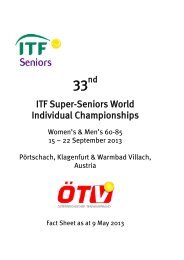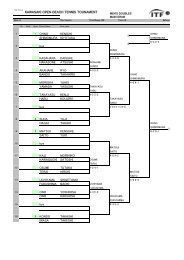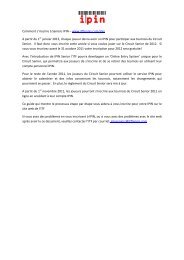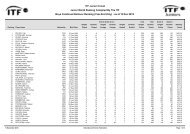Coaching & Sport Science Review - International Tennis Federation
Coaching & Sport Science Review - International Tennis Federation
Coaching & Sport Science Review - International Tennis Federation
Create successful ePaper yourself
Turn your PDF publications into a flip-book with our unique Google optimized e-Paper software.
A CASE STUDY – INTRODUCING A COMPETENCY-BASED COACH<br />
EDUCATION PROGRAM IN AUSTRALIA<br />
<strong>Tennis</strong> Australia adopted a competency-based approach to coach<br />
education in 2006. The shift to this approach presented a number of<br />
challenges and required significant changes to be made not only in<br />
the development of the courses but also in the way in which they are<br />
delivered.<br />
Figure 1. Current <strong>Tennis</strong> Australia coach education pathway.<br />
Criterion based training development and assessment<br />
Careful selection of competencies and performance criteria is critical in<br />
the development of a robust competency-based education program.<br />
Therefore, a thorough review of the skill sets required by coaches at<br />
each level of the coaching pathway was undertaken prior to writing<br />
the competency statements. Competencies with similar themes were<br />
grouped together to form units of competency. For example, the<br />
<strong>Tennis</strong> Australia Junior Development course (equivalent to the ITF level<br />
1) is designed to train coaches to develop players under 12 years of age.<br />
After consideration of the knowledge and skills required by coaches<br />
working in this role, seven units of competency were developed. These<br />
are:<br />
• Apply coaching methods to meet the needs of junior sports players<br />
• Undertake coaching activities in accord with professional and legal<br />
standards<br />
• Coach junior players to develop fundamental perceptual motor skills<br />
• Reflect and improve on professional coaching role and practice<br />
• Plan coaching programs for junior sports players<br />
• Interpret and apply rules of tennis<br />
ELEMENT OF COMPETENCY - ANALYSE AND CORRECT STROKE PRODUCTION AND TACTICS<br />
Performance Criteria Beginning (B) Developing (D) Competent (C)<br />
Individual and group progress<br />
is analysed and appropriate<br />
corrective strategies are<br />
selected<br />
Coach does not provide each<br />
player with specific technical<br />
coaching points<br />
<strong>Coaching</strong> points are very basic<br />
and global and are the same to all<br />
players<br />
<strong>Coaching</strong> points are not reinforced<br />
and vary throughout the session<br />
and in the closing of the session<br />
Player understanding is not<br />
checked through open or closed<br />
questioning<br />
• Coach junior tennis players to develop stroke production and tennis<br />
tactics<br />
Coach provides most player<br />
with specific technical coaching<br />
points but it may be many<br />
<strong>Coaching</strong> points are not specific<br />
to individual players, and in<br />
general it is the same to all<br />
players<br />
<strong>Coaching</strong> points are not<br />
reinforced and vary throughout<br />
the session and in the closing of<br />
the session<br />
Player understanding is checked<br />
through closed questioning<br />
Table 1. A performance criterion from the <strong>Tennis</strong> Australia Junior Development assessment rubric.<br />
Coach provides each player with 1-2<br />
key specific technical coaching points<br />
<strong>Coaching</strong> points are specific to<br />
individual players, although some<br />
may be general to the group if all<br />
players have same technical flaw<br />
<strong>Coaching</strong> points are reinforced<br />
throughout the session and in the<br />
closing of the session.<br />
Player understanding is checked<br />
through open and closed questioning<br />
These units of competency are made up of a number of elements<br />
of competency, each with specific performance criteria that are the<br />
standards by which coaches are measured. The training provided to<br />
coaches is structured to build the knowledge and skills of coaches to<br />
meet these standards. The major shift in the delivery of the training<br />
has been from a “lecture” model to a “learning through doing” model,<br />
with a range of thinking tools and practical activities to engage the<br />
participants being used to facilitate learning.<br />
The assessment tasks have been developed to allow coaches to<br />
provide evidence of their competence on an ongoing basis during the<br />
training. For example, in the Junior Development course, one of the<br />
assessment tasks requires coaches to deliver three 30-minute lessons.<br />
Each lesson is conducted on a different size court – red, orange then<br />
green – with different ages and levels of players. There is sufficient time<br />
between assessments for coach reflection and learning to take place.<br />
The increased focus on the selection of relevant competencies and<br />
performance criteria, with the delivery of the accompanying training<br />
program, have resulted in coaches developing the specific skill sets<br />
required to work effectively in their coaching roles.<br />
Assessment as part of the learning<br />
Assessment is ongoing in a competency-based learning environment.<br />
Prior to attending the course, coaches undertake an “assessment for<br />
learning.” This process allows the course coordinator to assess the<br />
coach’s current competence against the competency standards in<br />
order to tailor the program to their needs and to ensure they are placed<br />
with the most suitable Learning Facilitator. On-going assessment<br />
of a coach’s knowledge and skills is conducted during the training<br />
through observation and formal and informal assessments. Coaches<br />
are continually receiving feedback from their Learning Facilitator about<br />
their performance and while the formal assessment tasks are designed<br />
to measure “assessment of learning”, coaches report that significant<br />
learning occurs through this process (i.e., learning through assessment).<br />
Learning Facilitators not Presenters and Assessors<br />
Referring to those delivering training as Learning Facilitators instead<br />
of Presenters and Assessors has sent a clear message about the role of<br />
these individuals. Participants now view their Learning Facilitator as<br />
someone who is responsible for helping them to develop and improve.<br />
Likewise Learning Facilitators understand their role is not simply to<br />
present information and then assess the participant’s ability, but to use<br />
each and every opportunity within the course to facilitate learning and<br />
improve in the level of competency of each participant.<br />
19th Year, Issue 54, August 2011<br />
22


